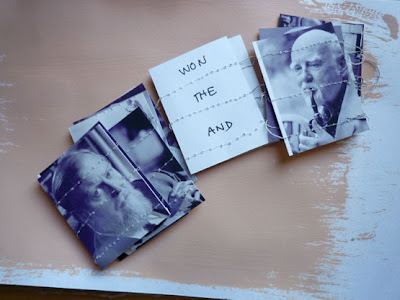The concept is to make a circular book - by sewing the pages together in an endless strip. The photos happened to be on hand, reject prints on photo paper, so they're nice and solid. They alternate front and back.
 What to put on the empty backs? The "found text" is from the little book you get at the Tate's Miro exhibition. On the outside of the circle, the three-letter words from one page of text. On the inside, four-letter words. The whole thing just flops about.
What to put on the empty backs? The "found text" is from the little book you get at the Tate's Miro exhibition. On the outside of the circle, the three-letter words from one page of text. On the inside, four-letter words. The whole thing just flops about.
 None of it makes any sense whatsoever, but this is an exercise in "thinking with your hands". To prove this wasn't just a waste of time (though it feels like it!), some lessons for "next time":
None of it makes any sense whatsoever, but this is an exercise in "thinking with your hands". To prove this wasn't just a waste of time (though it feels like it!), some lessons for "next time":
 What to put on the empty backs? The "found text" is from the little book you get at the Tate's Miro exhibition. On the outside of the circle, the three-letter words from one page of text. On the inside, four-letter words. The whole thing just flops about.
What to put on the empty backs? The "found text" is from the little book you get at the Tate's Miro exhibition. On the outside of the circle, the three-letter words from one page of text. On the inside, four-letter words. The whole thing just flops about. None of it makes any sense whatsoever, but this is an exercise in "thinking with your hands". To prove this wasn't just a waste of time (though it feels like it!), some lessons for "next time":
None of it makes any sense whatsoever, but this is an exercise in "thinking with your hands". To prove this wasn't just a waste of time (though it feels like it!), some lessons for "next time":-leave thread between pages sewn together in this way so that the sequence can fold up easily
-decide how it will fold up before starting sewing - this influences the order of elements
-think about the concept of the whole book rather than just adding random elements
-assess found elements more carefully as to suitability for a particular project














































